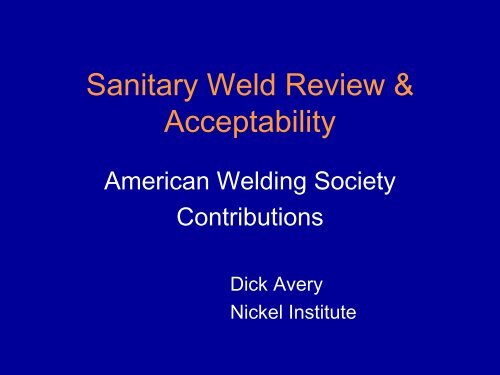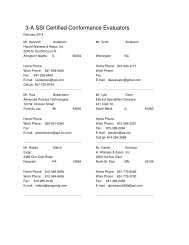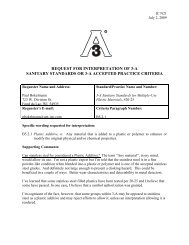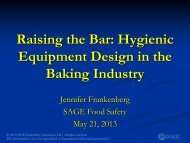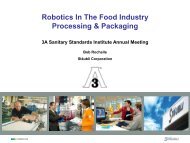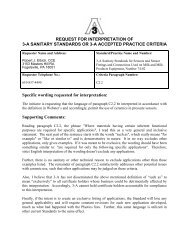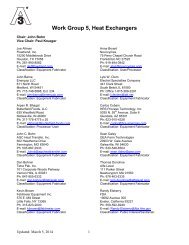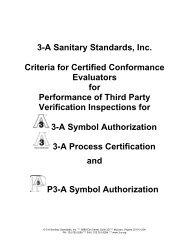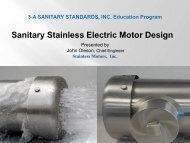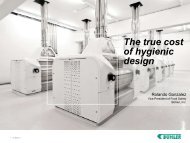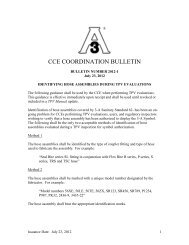Sanitary Weld Review & Acceptability - 3-A Sanitary Standards
Sanitary Weld Review & Acceptability - 3-A Sanitary Standards
Sanitary Weld Review & Acceptability - 3-A Sanitary Standards
You also want an ePaper? Increase the reach of your titles
YUMPU automatically turns print PDFs into web optimized ePapers that Google loves.
<strong>Sanitary</strong> <strong>Weld</strong> <strong>Review</strong> &<br />
<strong>Acceptability</strong><br />
American <strong>Weld</strong>ing Society<br />
Contributions<br />
Dick Avery<br />
Nickel Institute
3-A – AWS affiliation<br />
How it started<br />
• In mid 1990’s 3-A approached AWS for<br />
technical help on tube/pipe welding<br />
- concern was acceptability of ID tube/pipe<br />
welds not accessible visually<br />
• AWS D18 committee formed including<br />
Larry Hanson, Dick Smith & Dick Avery<br />
• AWS D18.1 completed ~ 2 years, a record<br />
for AWS documents
AWS Documents Developed for<br />
<strong>Sanitary</strong> (Hygienic) Applications<br />
• AWS D18.1 <strong>Weld</strong>ing of Austenitic<br />
Stainless Steel Tube and Pipe Systems in<br />
<strong>Sanitary</strong> (Hygienic) Applications<br />
• AWS D18.2 Guide to <strong>Weld</strong> Discoloration<br />
Levels on Inside of Austenitic Stainless<br />
Steel Tube<br />
• AWS D18.3 <strong>Weld</strong>ing of Tanks, Vessels,<br />
and Other Equipment in <strong>Sanitary</strong><br />
(Hygienic) Applications
<strong>Weld</strong> Acceptance Criteria<br />
3-A vs. AWS D18.1 (Tube/Pipe)<br />
• Many weld acceptance criteria are<br />
essentially the same, e.g.<br />
- no incomplete weld penetration, free<br />
from cracks & pits etc.<br />
• D18.1 is more explicate on the acceptance<br />
of weld features, such as ID convexity,<br />
concavity, allowance of slag like deposits<br />
on the weld surface
<strong>Weld</strong> Acceptance Criteria (cont)<br />
• D18.1 specifies Gas Tungsten Arc (TIG) or<br />
Plasma Arc – either manual or automatic<br />
• D18.3 allows all common fusion welding<br />
processes<br />
• D18.1 & D18.3 require a <strong>Weld</strong>ing Procedure<br />
Specification and <strong>Weld</strong>er Performance<br />
Qualification<br />
- 3-A does not require qualifications, but most<br />
fabricators probably are qualified for other end<br />
user applications<br />
- WPS may be more needed for field weld<br />
contractors
AWS D18.1 Judging ID <strong>Weld</strong> from OD<br />
<strong>Weld</strong> Appearance<br />
• Some weld ID’s inaccessible for viewing<br />
• Manual welders have characteristic<br />
“signatures” apparent on OD weld surface<br />
• <strong>Weld</strong>ers make 3 Preconstruction <strong>Weld</strong><br />
Samples (PWS) that meet all visual<br />
requirements<br />
• PWS are used to judge acceptability of<br />
welds impossible for ID inspection
Factors Influencing Heat Tint<br />
(Discoloration) on <strong>Weld</strong> ID<br />
• Oxygen in backing gas increases HT<br />
• Moisture in backing gas increases HT<br />
• Contaminants such as hydrocarbons<br />
increase discoloration<br />
• Hydrogen in backing gas decreases HT<br />
• Metal surface finish can affect HT<br />
appearance
AWS D18.2 (1999): Heat Tint Levels on the Inside of<br />
<strong>Weld</strong>ed 316L Austenitic Stainless Steel Tube<br />
The Sample Numbers refer to the amount of oxygen in the purging gas:<br />
No.1- 10ppm No.2 - 25ppm No.3 - 50ppm No.4 - 100ppm<br />
No.5 - 200ppm No.6 - 500ppm No. 7 - 1000ppm No.8 - 5000ppm<br />
No.9 -12500ppm No.10 -. 25000ppm<br />
Note: welds on type 304L SS showed no significant difference in heat<br />
tint colour from type 316L.
Heat Tint Acceptance Levels<br />
AWS D18.1<br />
• Acceptance levels are specified in D18.1,<br />
not in D18.2 – changes have been made<br />
• D18.1:1999 – Example 5 or higher is<br />
unacceptable in the as-welded condition<br />
• D18.1:2009 – Examples 4 through 10 is<br />
unacceptable in the as-welded condition,<br />
unless agreed upon by the Owner and<br />
Fabricator
Obtaining AWS D18.2<br />
• D18.2 standard size 8 ½ X 11<br />
non member $40.00<br />
• D18.2 large size 12 X 18 in.<br />
- same number as smaller size, but must<br />
specify the size<br />
non member $ 52.00<br />
• Ordered from: World Engineering Xchange<br />
phone North America 888 935 3454
Other Heat Tint Guides<br />
• All guides give O 2 levels for each color level but<br />
weld acceptance is based on oxide color not on<br />
O 2 level<br />
• ASME BPE 2012 will have set of photos, one<br />
with mechanical finish & one with EP<br />
- longer range to have set taken by boroscope<br />
• FORCE Institute Report 94.34 has 5 sets of<br />
various alloys & conditions<br />
• Good option is to make workmanship set for<br />
major projects using production<br />
material/practices
FORCE Institute<br />
Heat tints on pickled austenitic stainless steel tube butt welds<br />
made with Formier purging gas (NH10) containing known oxygen<br />
levels. * Heat input: 0.2-0.3 kJ/mm.
Relating Heat Tint to Corrosion<br />
BPE work<br />
• 5 backing gas O 2 ppm levels chosen: 10,<br />
25, 35, 50 & 80<br />
• Corrosion resistance of welded samples<br />
determined by:<br />
- ASTM G150 Critical Pitting Temp. test<br />
- Modified ASTM G61 Cyclic Polarization<br />
• All welds were tested in the as-welded<br />
condition with no post-weld conditioning
Heat Tint Acceptance Level - BPE<br />
• Electropolished surface - up to sample #4<br />
(50 ppm O 2 ) based on corrosion<br />
resistance similar to un-welded, EP 316L<br />
base metal<br />
• Mechanically polished – up to sample #3<br />
(35 ppm O 2 ) based on corrosion<br />
resistance similar to cold-rolled, millfinished<br />
316L base metal
Thank you for your<br />
attention<br />
Dick Avery


